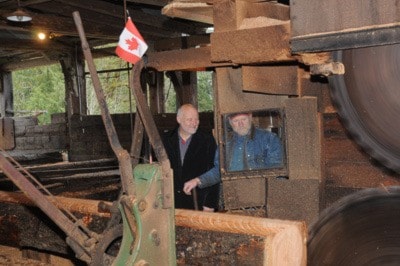As steam rose from below the floorboards of McLean Mill sawmill, mixing with Saturday morning's cold foggy air, Nanaimo-Alberni MP James Lunney joked with the volunteer mill workers who were preparing to fire up the saw for a special demonstration.
So caught up in the history of the mill and an explanation of its operation as a tourist attraction, Lunney briefly forgot who he was representing—environment minister Peter Kent, also minister responsible for Parks Canada—when he spoke "on behalf of Health Canada".
After some quick laughter from the small shivering crowd gathered on the mill's deck, Lunney announced Parks Canada funding to the tune of $48,000 to help conserve the sawmill complex. The money comes from the National Historic Sites Cost-Sharing program.
Designated a national historic site in 1989, McLean Mill is a rare surviving example of an early to mid-20th century logging and lumber operation. Established in 1925 by Robert Bartlett McLean, the mill was a family-run business until 1965. As years went on, it expanded into an industrial complex including a steam-operated sawmill, wooden residences and administrative buildings, a rail line, and facilities for a steam-powered locomotive.
A team of volunteers keeps the mill operational throughout the summer as a tourist destination and on special weekends in the fall. They have added a steam donkey and heel boom demonstration as well as regular steam train trips.
"There's no community like Port Alberni to take this industrial heritage and show it to the world," Lunney said before helping head sawyer Keith Young fire up the twin saw blades—137 centimetres (54 inches) on the bottom and 122 cm (48 in.) on the top—to trim the bark off a log and create a square beam.
"From this side it's amazing to see," said Lunney. "I tell people this is living history."
The Parks Canada grant is matching funding, mill manager Neil Malbon explained. The City of Port Alberni put up $24,000 and the balance has been made up of in-kind donations of the timbers from the mill itself, as well as volunteer labour.
"We're really excited and pleased with the funding," Malbon said. "The funds will ensure the long-term preservation of the sawmill complex, and in doing so protect the initial investment by Parks Canada and partners."
Conservation work is in progress, although it has been stalled because of weather. "We're probably halfway or three-quarters of the way there," Malbon said. "We're basically shut down because of winter and the holiday."
The funding will be used to repair support posts, the boom shake float, sawmill decking, waste conveyor, planer and upgrade the electrical system. When some of the decking was replaced in the spring crews discovered some of the support posts that had been exposed to the elements have rotted, Malbon said.
Work will start up again at the end of January. Malbon has applied for another grant which would allow crews to continue replacing posts in the basement as well as replace the log haul.
Last year the mill received a $25,000 Heritage Legacy Fund grant, which was used to replace the floor in the Arnold McLean House, re-shake the locie shed, fix up the foundation, siding and window sill of Howard McLean's office, fix the foundation and tilting pantry in the cookhouse, and begin foundation work on the teacherage.
Conservation projects have to be done meticulously at the mill because it is designated a national historic site, Malbon explained. Each modification has to be documented, and use material from the same era if possible.
When the buildings were worked on in the summer, the biggest challenge was keeping that original integrity, Alberni Valley Museum collections curator Kirsten Smith said. the original builders "didn't always do it in the best way that could be done," but their methods had to be followed.
The list of conservation projects at the mill is "extensive and ongoing," she said. Some of the foundations that were replaced in the spring had originally been restored or stabilized in the mid-1990s, in anticipation of opening to the public.
"Some of the buildings are quite deteriorated. It's hard choices," she said.
But the work must be done, she added. "It's our heritage. We don't want to just tear (the mill) down and build something that looks like it. We want to maintain the integrity of the buildings."
editor@albernivalleynews.com
-30-
